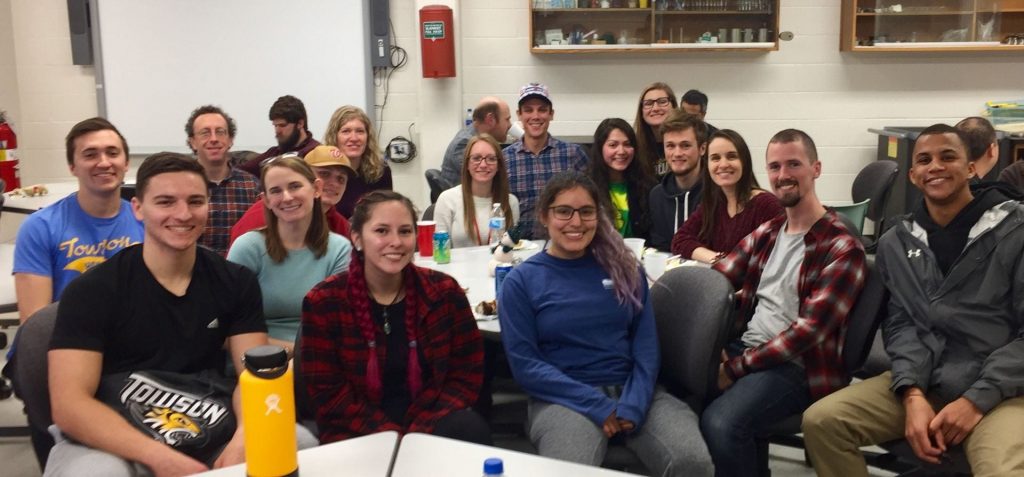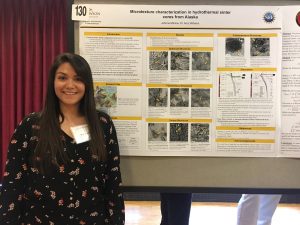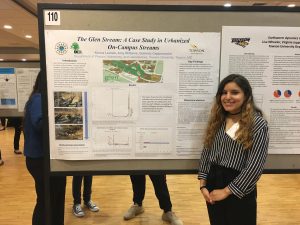MS student Lauren Judge has received a prestigious Masters Fellowship from the Florida Space Grant Consortium! Learn more about the consortium at https://floridaspacegrant.org/.
NASA Astrobiology interview – Countdown to Mars for the Perseverance rover launch
NASA Astrobiology interview – Countdown to Mars for the Perseverance rover launch
Dr. Amy Williams discusses the 3 astrobiology goals of this mission: determining the habitability of Jezero crater, searching for geology with the highest potential for biosignature preservation, and searching for evidence of ancient life. Click to watch on the NASA Astrobiology YouTube channel. Image credit: Mike Toillion / NASA Astrobiology.
LotE Lab member Kenna Leonzo highlighted on TU News
From a walk in the woods to the Commencement stage
See the full article here
By Megan Bradshaw on May 5, 2019
Visiting TU’s Glen put Kenna Leonzo ’19 on a path to an environmental science career
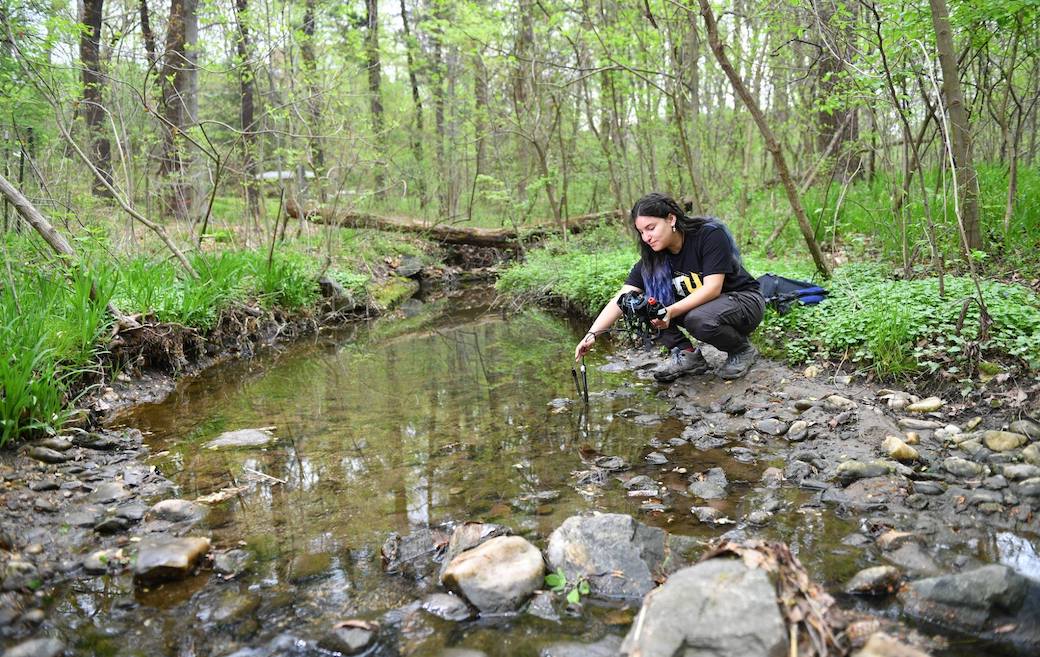
Graduating senior Kenna Leonzo knew she wanted to come to Towson University the moment she stepped into The Glen.
The Fort Washington, Maryland, native had come to visit her brother Javier Leonzo ’15, and he showed her around TU’s 329-acre campus. The 10 wooded acres in the center seemed “huge” to her and appealed to her love of nature.
“Just walking into The Glen…it was green and vibrant. There were students studying there. It looked like somewhere I wanted to be. There was such good energy,” Leonzo recalls.
When she arrived at TU, she declared a major in film, pondering a future in nature documentaries. A spin through the Involvement Fair introduced her to the Student Environmental Organization—she is now the vice president—and convinced her to switch her major to environmental science.
Former TU professor Amy Williams’ physical geology class settled her on a major in geology.
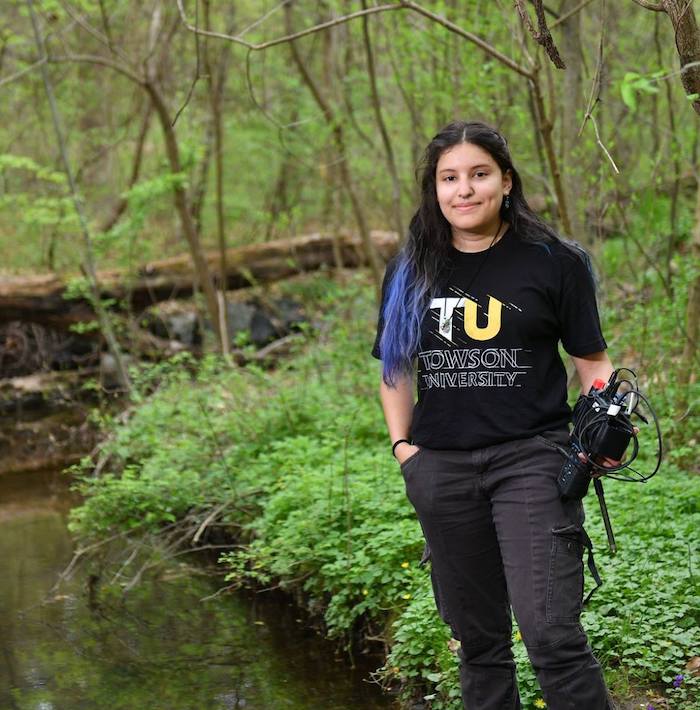
“From the first class, I was amazed,” remembers Leonzo. “I sat in the front, probably with my mouth hanging open. There was a lab where I got to do hands-on work; I loved taking water samples. Dr. Williams noticed how much I loved the class and invited me into her lab at the end of the semester.”
Leonzo credits her mentor relationship with Williams with offering her opportunities to learn practical skills and giving her a career direction.
“Dr. Williams is amazing. She was available to talk to me and really showed me my passion for geology,” she says. “Her class was terrific. I took all her other classes and even sat in on a few of her geobiology classes. She truly, truly cares for her students.”
A Dean’s List student, Leonzo conducted water chemistry quality research on local streams that flow into Lake Roland—including The Glen’s stream—to find the overall water chemistry quality and impact that TU has on certain waterways.
Learn about undergraduate research opportunities in Fisher College
She presented her research findings at the American Geophysical Union in Washington, D.C., in December 2018.
“Being an undergraduate presenter was a huge honor,” Leonzo says. “Most of the other presenters were well-known scientists or graduate and postgraduate students. It was great to walk around and meet people in the field.”
Leonzo also participated in the Research Experience for Undergraduates (REU) program, interning with the United States Forest Service and serving as a field manager for Environment Maryland.
Her hard work paid off: Leonzo will leave TU with a job as an industrial hygienist technician for Global Consulting, Inc., where she’ll work on multiple environmental hazardous waste projects.
The soon-to-be alumna has some advice for fellow science majors still working their way to graduation: find a mentor.
“Reaching out to faculty mentors is the best thing you can do,” she stresses. “They want to hear about your interest and help you.”
Curiosity Tastes First Sample in ‘Clay-Bearing Unit’
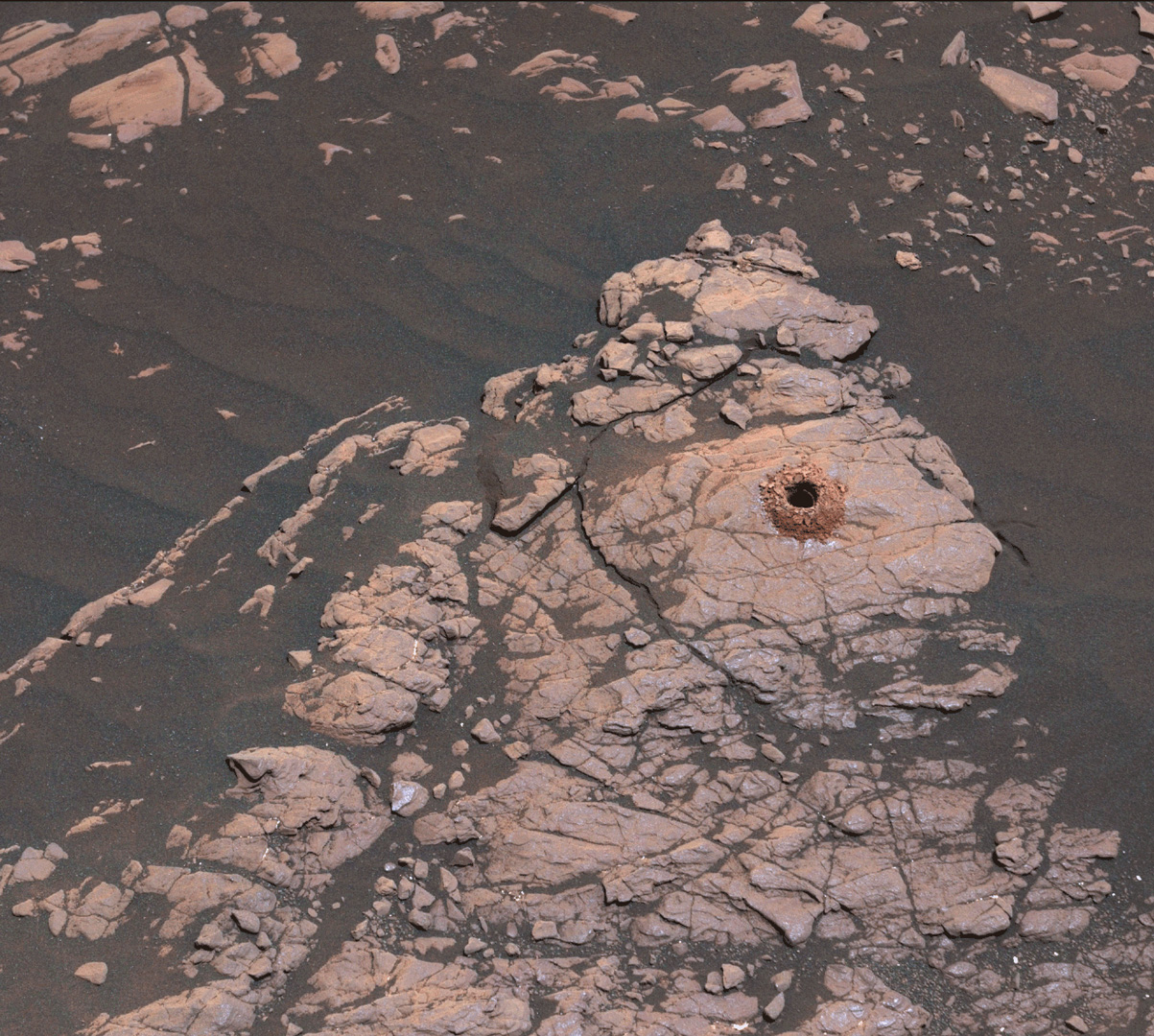 See the full article at: https://www.jpl.nasa.gov/news/news.php?feature=7376
See the full article at: https://www.jpl.nasa.gov/news/news.php?feature=7376
Scientists working with NASA’s Curiosity Mars rover have been excited to explore a region called “the clay-bearing unit” since before the spacecraft launched. Now, the rover has finally tasted its first sample from this part of Mount Sharp. Curiosity drilled a piece of bedrock nicknamed “Aberlady” on Saturday, April 6 (the 2,370th Martian day, or sol, of the mission), and delivered the sample to its internal mineralogy lab on Wednesday, April 10 (Sol 2374).
The rover’s drill chewed easily through the rock, unlike some of the tougher targets it faced nearby on Vera Rubin Ridge. It was so soft, in fact, that the drill didn’t need to use its percussive technique, which is helpful for snagging samples from harder rock. This was the mission’s first sample obtained using only rotation of the drill bit.
“Curiosity has been on the road for nearly seven years,” said Curiosity Project Manager Jim Erickson of NASA’s Jet Propulsion Laboratory in Pasadena, California. “Finally drilling at the clay-bearing unit is a major milestone in our journey up Mount Sharp.”
Scientists are eager to analyze the sample for traces of clay minerals because they usually form in water. NASA’s Mars Reconnaissance Orbiter (MRO) spied a strong clay “signal” here long before Curiosity landed in 2012. Pinpointing the source of that signal could help the science team understand if a wetter Martian era shaped this layer of Mount Sharp, the 3-mile-tall (5-kilometer-tall) mountain Curiosity has been climbing.
Curiosity has discovered clay minerals in mudstones all along its journey. These mudstones formed as river sediment settled within ancient lakes nearly 3.5 billion years ago. As with water elsewhere on Mars, the lakes eventually dried up.
The clay beacon seen from space brought the rover here, but the region clearly has several other stories to tell. Now that Curiosity is searching this area, scientists can peer around as geological tourists, finding a landscape both ancient and new. There are several kinds of bedrock and sand, including active sand ripples that have shifted in the past year. Pebbles are scattered everywhere – are they eroding from the local bedrock? Several eye-catching landmarks, such as “Knockfarril Hill,” stick out as well.
“Each layer of this mountain is a puzzle piece,” said Curiosity Project Scientist Ashwin Vasavada of JPL. “They each hold clues to a different era in Martian history. We’re excited to see what this first sample tells us about the ancient environment, especially about water.”
The Aberlady sample will give the team a starting point for thinking about the clay-bearing unit. They plan to drill several more times over the course of the next year. That will help them understand what makes this region different from the ridge behind it and an area with a sulfate signal up higher on the mountain.
LotE Lab Students Present at AGU Fall Meeting 2018
Several students from the LotE Lab presented their research at the 2018 AGU Fall Meeting in Washington DC this December. Congrats on their excellent posters!
- Chris Cook: Cook, C.L., Williams, A.J., K. P. Reber, K. E. Kautzman, M. M. Floyd, 2018. Spectral Characterization of Pterin Molecules: Implications for Detecting Life on Mars. AGU Fall Meeting, Washington, D.C., December 2018.
- Kenna Leonzo: Leonzo, K., A.J. Williams, T. Pearson, T. VanNess, D. Capparuccini, 2018. An On-Campus Case Study in Urbanized Streams: The Historic Glen Stream, Towson, MD. AGU Fall Meeting, Washington, D.C.
- JoAnna Marlow: Marlow, J.G., A.J. Williams, Craft, K., 2018. Microtexture Characterization in Hydrothermal Sinter Cores from Alaska. AGU Fall Meeting, Washington, D.C.
- Evan O’Neal: O’Neal, E.W., Williams, A.J., 2018. Detection of Physical Biosignatures in Drill Fines via SEM for Future Planetary Missions. AGU Fall Meeting, Washington, D.C.
The LotE lab move to UF is complete!
The LotE lab is officially now located at the University of Florida. The lab is being set up, the new Agilent GC-MS is delivered, and Phenom ProX SEM is on its way!
Many thanks to the amazing people at Towson University for their support over the past several years. Here’s a picture from the department holiday party with my beloved colleagues and students. I’ll miss you all!
Paid Summer Undergraduate Research in Astrobiology at UF!
Paid Summer Undergraduate Research at Florida,
May 25, 2019 – August 2, 2019
Join the LotE Lab as an undergraduate non-UF student for a summer research experience in astrobiology – the path to a PhD in Astrobiology/ Geobiology at UF. Applications due December 14 (but apply before then!). Contact me at amywilliams1 “at” ufl.edu to discuss astrobiology/ geobiology projects in the lab prior to applying.
The SURF program (https://www.eng.ufl.edu/surf/) entails a 10 week Summer Undergraduate Research experience at the University of Florida. Prospective Ph.D. students for the University of Florida for the fall 2020 term will be considered for SURF. SURF provides the opportunity to work with a premier faculty adviser and a senior Ph.D. student mentor. Students will engage in research and spend in depth time furthering their path to applying and enrolling in a Ph.D. program at the University of Florida. All participants will be eligible to receive preferred Ph.D. admission and fellowship offers provided they have a successful summer experience and maintain their level of high academic performance through the completion of their bachelor’s degree. All costs for SURF participants are paid by UF including room and some board, a $5,000 summer stipend, round-trip flights/mileage to Gainesville, summer workshops, social events/activities and a GRE test prep course.
ELIGIBILITY
1) SURF participants for summer 2019 must be Junior or Senior level undergraduate students graduating with a bachelor’s degree between December 2019 through August 2020 (some Colleges may elect to invite Sophomore/Junior students).
2) U.S. Citizens or Permanent Residents.
3) Minimum 3.50 cumulative undergraduate GPA.
4) Priority consideration for all SURF positions are given to students with serious intentions to enroll in a University of Florida Ph.D. program for the fall 2020 term (at UF students can apply to a Ph.D. program directly from the completion of their bachelor’s degree. A master’s degree is achieved in route to the Ph.D.). The University of Florida agrees to provide Ph.D. application fee waivers to all SURF participants. All 2019 SURF participants are required to apply UF Ph.D. beginning with the fall 2020 term.
5) In the Herbert Wertheim College of Engineering preference for SURF selection will be given to students who attended the 2018 Junior Preview.
6) Complete the SURF online application including your preferred faculty/research projects of interest, resume, unofficial transcripts, statement of Ph.D. interest at UF, optional letters of recommendation.
7) Students should not be enrolling in any classes while participating in SURF. You will be committed to full time summer research at UF (i.e. 40+ hours a week), GRE test prep course (pre-test, classes for 2 hours each twice a week, sample tests, post test), weekly luncheon seminars, social events, and any additional faculty mentor requirements all in a short 10 week timespan.
8) SURF is a residential program at UF in Gainesville. All participants are required to live in UF residence halls and cannot daily commute to campus. However, students within a couple of hours drive to Gainesville are permitted to have a car throughout the summer with a UF parking permit.
LotE Lab Student Chris Cook Presents his Senior Thesis at the 2018 Lunar and Planetary Science Conference
Congratulations to Chris Cook who presented his Senior Thesis research at the 2018 Lunar and Planetary Science Conference in The Woodlands, TX, in March. Chris’ research is on the spectral characterization of pterin molecules, which may be part of a biomarker for iron oxidizing organisms. Chris will be attending graduate school this fall at the University of Tennessee, Knoxville. Congrats, Chris!
LotE Lab Students Present Research @ 2018 TU Research and Creative Inquiry Symposium
NASA’s Curiosity Mars Rover Climbing Toward Ridge Top
Amy Williams is working with the NASA Mars Curiosity rover team to plan the sampling campaign at the Vera Rubin (Hematite) Ridge on Mt. Sharp in Gale Crater. Read more about the current exploration below or at https://mars.nasa.gov/news/2017/nasas-curiosity-mars-rover-climbing-toward-ridge-top
NASA’s Mars rover Curiosity has begun the steep ascent of an iron-oxide-bearing ridge that’s grabbed scientists’ attention since before the car-sized rover’s 2012 landing.
“We’re on the climb now, driving up a route where we can access the layers we’ve studied from below,” said Abigail Fraeman, a Curiosity science-team member at NASA’s Jet Propulsion Laboratory in Pasadena, California.
The ascent to the top of the ridge from a transition in rock-layer appearance at the bottom of it will gain about 213 feet (65 meters) of elevation — about 20 stories. The climb requires a series of drives totaling a little more than a third of a mile (570 meters). Before starting this ascent in early September, Curiosity had gained a total of about 980 feet (about 300 meters) in elevation in drives totaling 10.76 miles (17.32 kilometers) from its landing site to the base of the ridge.
Curiosity’s telephoto observations of the ridge from just beneath it show finer layering, with extensive bright veins of varying widths cutting through the layers.”Now we’ll have a chance to examine the layers up close as the rover climbs,” Fraeman said.
Curiosity Project Scientist Ashwin Vasavada of JPL said, “Using data from orbiters and our own approach imaging, the team has chosen places to pause for more extensive studies on the way up, such as where the rock layers show changes in appearance or composition. But the campaign plan will evolve as we examine the rocks in detail. As always, it’s a mix of planning and discovery.”
In orbital spectrometer observations, the iron-oxide mineral hematite shows up more strongly at the ridge top than elsewhere on lower Mount Sharp, including locations where Curiosity has already found hematite. Researchers seek to gain better understanding about why the ridge resists erosion, what concentrated its hematite, whether those factors are related, and what the rocks of the ridge can reveal about ancient Martian environmental conditions.”The team is excited to be exploring Vera Rubin Ridge, as this hematite ridge has been a go-to target for Curiosity ever since Gale Crater was selected as the landing site,” said Michael Meyer, lead scientist of NASA’s Mars Exploration Program at the agency’s Washington headquarters.
During the first year after its landing near the base of Mount Sharp, the Curiosity mission accomplished a major goal by determining that billions of years ago, a Martian lake offered conditions that would have been favorable for microbial life. Curiosity has since traversed through a diversity of environments where both water and wind have left their imprint. Vera Rubin Ridge and layers above it that contain clay and sulfate minerals provide tempting opportunities to learn even more about the history and habitability of ancient Mars.
For more about Curiosity, visit:

